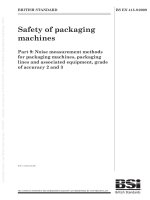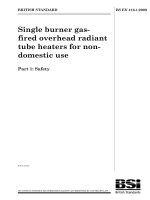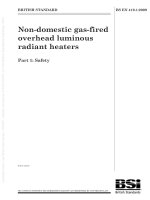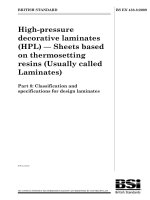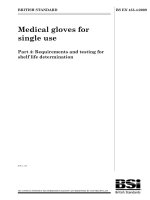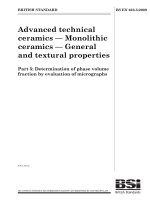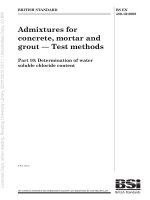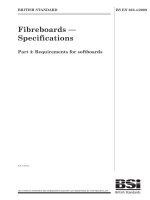Bsi bs en 62453 309 2009
Bạn đang xem bản rút gọn của tài liệu. Xem và tải ngay bản đầy đủ của tài liệu tại đây (1.89 MB, 32 trang )
Licensed Copy: Wang Bin, ISO/EXCHANGE CHINA STANDARDS, 15/04/2010 02:01, Uncontrolled Copy, (c) BSI
BS EN 62453-309:2009
BSI Standards Publication
Field device tool (FDT) interface
specification —
Part 309: Communication profile integration —
IEC 61784 CPF 9
NO COPYING WITHOUT BSI PERMISSION EXCEPT AS PERMITTED BY COPYRIGHT LAW
raising standards worldwide™
Licensed Copy: Wang Bin, ISO/EXCHANGE CHINA STANDARDS, 15/04/2010 02:01, Uncontrolled Copy, (c) BSI
BRITISH STANDARD
BS EN 62453-309:2009
National foreword
This British Standard is the UK implementation of EN 62453-309:2009. It is
identical to IEC 62453-309:2009.
The UK participation in its preparation was entrusted to Technical Committee
AMT/7, Industrial communications: process measurement and control,
including fieldbus.
A list of organizations represented on this committee can be obtained on
request to its secretary.
This publication does not purport to include all the necessary provisions of a
contract. Users are responsible for its correct application.
© BSI 2010
ISBN 978 0 580 62565 7
ICS 25.040.40; 35.100.05; 35.110
Compliance with a British Standard cannot confer immunity from
legal obligations.
This British Standard was published under the authority of the Standards
Policy and Strategy Committee on 31 January 2010
Amendments issued since publication
Amd. No.
Date
Text affected
Licensed Copy: Wang Bin, ISO/EXCHANGE CHINA STANDARDS, 15/04/2010 02:01, Uncontrolled Copy, (c) BSI
BS EN 62453-309:2009
EUROPEAN STANDARD
EN 62453-309
NORME EUROPÉENNE
October 2009
EUROPÄISCHE NORM
ICS 25.040.40; 35.100.05; 35.110
English version
Field device tool (FDT) interface specification Part 309: Communication profile integration IEC 61784 CPF 9
(IEC 62453-309:2009)
Spécification des interfaces des outils
des dispositifs de terrain (FDT) Partie 309: Intégration des profils
de communication CEI 61784 CPF 9
(CEI 62453-309:2009)
Field Device Tool (FDT)Schnittstellenspezifikation Teil 309: Integration
von Kommunikationsprofilen Kommunikationsprofilfamilie (CPF) 9
nach IEC 61784
(IEC 62453-309:2009)
This European Standard was approved by CENELEC on 2009-08-01. CENELEC members are bound to comply
with the CEN/CENELEC Internal Regulations which stipulate the conditions for giving this European Standard
the status of a national standard without any alteration.
Up-to-date lists and bibliographical references concerning such national standards may be obtained on
application to the Central Secretariat or to any CENELEC member.
This European Standard exists in three official versions (English, French, German). A version in any other
language made by translation under the responsibility of a CENELEC member into its own language and notified
to the Central Secretariat has the same status as the official versions.
CENELEC members are the national electrotechnical committees of Austria, Belgium, Bulgaria, Cyprus, the
Czech Republic, Denmark, Estonia, Finland, France, Germany, Greece, Hungary, Iceland, Ireland, Italy, Latvia,
Lithuania, Luxembourg, Malta, the Netherlands, Norway, Poland, Portugal, Romania, Slovakia, Slovenia, Spain,
Sweden, Switzerland and the United Kingdom.
CENELEC
European Committee for Electrotechnical Standardization
Comité Européen de Normalisation Electrotechnique
Europäisches Komitee für Elektrotechnische Normung
Central Secretariat: Avenue Marnix 17, B - 1000 Brussels
© 2009 CENELEC -
All rights of exploitation in any form and by any means reserved worldwide for CENELEC members.
Ref. No. EN 62453-309:2009 E
Licensed Copy: Wang Bin, ISO/EXCHANGE CHINA STANDARDS, 15/04/2010 02:01, Uncontrolled Copy, (c) BSI
BS EN 62453-309:2009
EN 62453-309:2009
-2-
Foreword
The text of document 65E/130/FDIS, future edition 1 of IEC 62453-309, prepared by SC 65E, Devices and
integration in enterprise systems, of IEC TC 65, Industrial-process measurement, control and automation,
was submitted to the IEC-CENELEC parallel vote and was approved by CENELEC as EN 62453-309 on
2009-08-01.
Each part of the EN 62453-3xy series is intended to be read in conjunction with EN 62453-2.
The following dates were fixed:
– latest date by which the EN has to be implemented
at national level by publication of an identical
national standard or by endorsement
(dop)
2010-05-01
– latest date by which the national standards conflicting
with the EN have to be withdrawn
(dow)
2012-08-01
Annex ZA has been added by CENELEC.
__________
Endorsement notice
The text of the International Standard IEC 62453-309:2009 was approved by CENELEC as a European
Standard without any modification.
__________
Licensed Copy: Wang Bin, ISO/EXCHANGE CHINA STANDARDS, 15/04/2010 02:01, Uncontrolled Copy, (c) BSI
-3-
BS EN 62453-309:2009
EN 62453-309:2009
Annex ZA
(normative)
Normative references to international publications
with their corresponding European publications
The following referenced documents are indispensable for the application of this document. For dated
references, only the edition cited applies. For undated references, the latest edition of the referenced
document (including any amendments) applies.
NOTE When an international publication has been modified by common modifications, indicated by (mod), the relevant EN/HD
applies.
Publication
Year
Title
EN/HD
Year
1)
EN 61158-5-20
Industrial communication networks Fieldbus specifications Part 5-20: Application layer service definition Type 20 elements
2008
2)
1)
Industrial communication networks Fieldbus specifications Part 6-20: Application layer protocol
specification - Type 20 elements
EN 61158-6-20
2008
2)
1)
2)
IEC 61158-5-20
–
IEC 61158-6-20
–
IEC 61784-1
–
Industrial communication networks Profiles Part 1: Fieldbus profiles
EN 61784-1
2008
IEC 62453-1
2009
Field device tool (FDT) interface specification - EN 62453-1
Part 1: Overview and guidance
2009
IEC 62453-2
2009
Field device tool (FDT) interface specification - EN 62453-2
Part 2: Concepts and detailed description
2009
1)
Undated reference.
2)
Valid edition at date of issue.
Licensed Copy: Wang Bin, ISO/EXCHANGE CHINA STANDARDS, 15/04/2010 02:01, Uncontrolled Copy, (c) BSI
BS EN 62453-309:2009
–2–
62453-309 © IEC:2009(E)
CONTENTS
INTRODUCTION.....................................................................................................................6
1
Scope ...............................................................................................................................7
2
Normative references .......................................................................................................7
3
Terms, definitions, symbols, abbreviated terms and conventions ...................................... 7
3.1
3.2
3.3
4
Terms and definitions ..............................................................................................7
Abbreviated terms ...................................................................................................8
Conventions ............................................................................................................8
3.3.1 Data type names and references to data types ............................................8
3.3.2 Vocabulary for requirements ........................................................................8
3.3.3 Use of UML .................................................................................................8
Bus category ....................................................................................................................8
5
Access to instance and device data ..................................................................................8
6
5.1 Process Channel objects provided by DTM..............................................................8
5.2 DTM services to access instance and device data ...................................................9
Protocol specific behavior.................................................................................................9
7
6.1 Overview .................................................................................................................9
6.2 Burst mode subscription ..........................................................................................9
Protocol specific usage of general data types ................................................................. 10
8
Protocol specific common data types .............................................................................. 11
9
Network management data types .................................................................................... 11
10 Communication data types ............................................................................................. 11
11 Channel parameter data types ........................................................................................ 15
12 Device identification ....................................................................................................... 17
12.1 Protocol specific handling of data type STRING .................................................... 17
12.2 Common device type identification data types ....................................................... 17
12.3 Topology scan data types ...................................................................................... 22
12.4 Scan identification data types ................................................................................ 23
12.5 Device type identification data types – provided by DTM ....................................... 24
Bibliography.......................................................................................................................... 27
Figure 1 – Part 309 of the IEC 62453 series ...........................................................................6
Figure 2 – Burst mode subscription ....................................................................................... 10
Table 1 – Protocol identifiers ..................................................................................................8
Table 2 – Protocol specific usage of general data types ........................................................ 10
Table 3 – Simple communication data types ......................................................................... 11
Table 4 – Structured communication data types .................................................................... 12
Table 5 – Simple channel parameter data types .................................................................... 16
Table 6 – Structured channel parameter data types .............................................................. 16
Table 7 – Identification data types with protocol specific mapping ......................................... 19
Table 8 – Identification data types without protocol independent semantics .......................... 21
Table 9 – Simple identification data types with protocol independent semantics.................... 22
Licensed Copy: Wang Bin, ISO/EXCHANGE CHINA STANDARDS, 15/04/2010 02:01, Uncontrolled Copy, (c) BSI
BS EN 62453-309:2009
62453-309 © IEC:2009(E)
–3–
Table 10 – Structured identification data types with protocol independent semantics ............ 22
Table 11 – Structured device type identification data types ................................................... 22
Table 12 – Simple scan identification data types ................................................................... 23
Table 13 – Structured scan identification data types ............................................................. 23
Table 14 – Structured device type identification data types ................................................... 25
Licensed Copy: Wang Bin, ISO/EXCHANGE CHINA STANDARDS, 15/04/2010 02:01, Uncontrolled Copy, (c) BSI
BS EN 62453-309:2009
62453-309 © IEC:2009(E)
–6–
INTRODUCTION
This part of IEC 62453 is an interface specification for developers of FDT (Field Device Tool)
components for function control and data access within a client/server architecture. The
specification is a result of an analysis and design process to develop standard interfaces to
facilitate the development of servers and clients by multiple vendors that need to interoperate
seamlessly.
With the integration of fieldbusses into control systems, there are a few other tasks which
need to be performed. In addition to fieldbus- and device-specific tools, there is a need to
integrate these tools into higher-level system-wide planning- or engineering tools. In
particular, for use in extensive and heterogeneous control systems, typically in the area of the
process industry, the unambiguous definition of engineering interfaces that are easy to use for
all those involved is of great importance.
A device-specific software component, called DTM (Device Type Manager), is supplied by the
field device manufacturer with its device. The DTM is integrated into engineering tools via the
FDT interfaces defined in this specification. The approach to integration is in general open for
all kind of fieldbusses and thus meets the requirements for integrating different kinds of
devices into heterogeneous control systems.
Figure 1 shows how IEC 62453-309 is aligned in the structure of the IEC 62453 series.
Part 309
Communication
profile integration –
IEC 61784 CPF 9
IEC
1134/09
Figure 1 – Part 309 of the IEC 62453 series
Licensed Copy: Wang Bin, ISO/EXCHANGE CHINA STANDARDS, 15/04/2010 02:01, Uncontrolled Copy, (c) BSI
BS EN 62453-309:2009
62453-309 © IEC:2009(E)
–7–
FIELD DEVICE TOOL (FDT) INTERFACE SPECIFICATION –
Part 309: Communication profile integration –
IEC 61784 CPF 9
1
Scope
Communication Profile Family 9 (commonly known as HART® 1) defines communication
profiles based on IEC 61158-5-20 and IEC 61158-6-20. The basic profile CP 9/1 is defined in
IEC 61784-1.
This part of IEC 62453 provides information for integrating the HART® technology into the
FDT standard (IEC 62453-2).
This part of the IEC 62453 specifies communication and other services.
This standard neither contains the FDT specification nor modifies it.
2
Normative references
The following referenced documents are indispensable for the application of this specification.
For dated references, only the edition cited applies. For undated references, the latest edition
of the referenced document (including any amendments) applies
IEC 61158-5-20, Industrial communication networks – Fieldbus specifications – Part 5-20:
Application layer service definition – Type 20 elements
IEC 61158-6-20, Industrial communication networks – Fieldbus specifications – Part 6-20:
Application layer protocol specification – Type 20 elements
IEC 61784-1, Industrial communication networks – Profiles – Part 1: Fieldbus profiles
IEC 62453-1:2009,
guidance
Field Device Tool (FDT) interface specification – Part 1: Overview and
IEC 62453-2:2009, Field Device Tool (FDT) interface specification – Part 2: Concepts and
detailed description
3
3.1
Terms, definitions, symbols, abbreviated terms and conventions
Terms and definitions
For the purposes of this document, the terms and definitions given in IEC 62453-1 and
IEC 62453-2 and the following apply.
—————————
1 HART ® is the trade name of the product supplied by HART Communication Foundation. This information is
given for convenience of users of this document and does not constitute an endorsement by IEC of the product
named. Equivalent products may be used if they can be shown to lead to the same results.
Licensed Copy: Wang Bin, ISO/EXCHANGE CHINA STANDARDS, 15/04/2010 02:01, Uncontrolled Copy, (c) BSI
BS EN 62453-309:2009
62453-309 © IEC:2009(E)
–8–
3.1.1
burst mode
mode in which the field device generates response telegrams without request telegram from
the master
3.2
Abbreviated terms
For the purposes of this document, the abbreviations given in IEC 62453-1, IEC 62453-2 and
the following apply.
3.3
BACK
Burst ACKnowledge
UML
Unified Modelling Language
Conventions
3.3.1
Data type names and references to data types
The conventions for naming and referencing of data types are explained in IEC 62453-2,
Clause A.1
3.3.2
Vocabulary for requirements
The following expressions are used when specifying requirements.
3.3.3
Usage of “shall” or
“mandatory”
No exceptions allowed.
Usage of “should” or
“recommended”
Strong recommendation. It may make sense in special
exceptional cases to differ from the described behaviour.
Usage of “can’ or “optional’
Function or behaviour may be provided, depending on
defined conditions.
Use of UML
Figures in this document are using UML notation as defined in Annex A of IEC 62453-1.
4
Bus category
IEC 61784 CPF 9 protocol is identified in the protocolId element of structured data type
'fdt:BusCategory' by the following unique identifier (Table 1):
Table 1 – Protocol identifiers
Identifier value
036D1498-387B-11D4-86E1-00E0987270B9
5
5.1
ProtocolId name
‘HART’
Description
Support of IEC 61784 CPF 9 protocol
Access to instance and device data
Process Channel objects provided by DTM
The minimum set of provided data shall be:
•
the first four provided process related values (PV, SV, …) - if available - are modeled as
channel references. The referenced channel shall include ranges and scaling.
Licensed Copy: Wang Bin, ISO/EXCHANGE CHINA STANDARDS, 15/04/2010 02:01, Uncontrolled Copy, (c) BSI
BS EN 62453-309:2009
62453-309 © IEC:2009(E)
5.2
–9–
DTM services to access instance and device data
The services InstanceDataInformation and DeviceDataInformation shall provide access to at
least to all parameters of the Universal and Common Practice commands (as far as the device
supports the function).
Furthermore, the Response Byte 0 and the Response Byte 1 for each command shall be
exposed.
The services InstanceDataInformation and DeviceDataInformation may also provide access to
device specific parameters (e.g. diagnostic information).
6
6.1
Protocol specific behavior
Overview
There is only one protocol specific sequence defined for IEC 61784 CPF 9:
•
burst mode subscription.
This sequence explains how the sequence “”, defined in Part 2 of this standard, is applied in
context of burst telegrams as defined by IEC 61784 CPF 9.
6.2
Burst mode subscription
A subscription to device initiated data transfer can be requested by sending a transaction
request with SubscribeRequest content (see Figure 2). The Communication Channel may
detect if the device is already in burst mode.
NOTE In HART 5 this can be detected only when burst frames are received from the device. In HART 6 the burst
mode can be detected using command 105.
The Communication Channel answers to a SubscribeRequest with a SubscribeResponse
content. If burst frames are received, the device is in burst mode and burstModeDetected
value is set to TRUE. This means that Device DTM will start to receive burst messages via the
transaction response mechanism. In the case that no burst messages were received,
burstModeDetected value is set to FALSE. It is up to Device DTM to set device into burst
mode. Then Device DTM may call a transaction request with SubscribeRequest content again
in order to receive burst messages.
In order to unsubscribe, the Device DTM sends a transaction request with a
UnsubcribeRequest. The Communication Channel answers with a SubscribeResponse where
burstModeDetected value is set to FALSE. The Device DTM will not receive any more burst
information via the transaction response mechanism. The Communication Channel does not
switch off the burst mode in the device. The Device DTM may switch burst mode on or off by
using normal transaction requests (command 109). This is independent of the subscription.
Licensed Copy: Wang Bin, ISO/EXCHANGE CHINA STANDARDS, 15/04/2010 02:01, Uncontrolled Copy, (c) BSI
BS EN 62453-309:2009
62453-309 © IEC:2009(E)
– 10 –
Device DTM
Communication Channel
Device
TransactionRequest()
Subscribe request for device
initialized transaction mode
[*] BACK response
Get information about active
burst mode (subscription mode
’on’)
OnTransactionResponse()
Communication Channel
detects burst
frames
[*] BACK response
Receives burst frames via
transaction responses without
requests.
[*] OnTransactionResponse
TransactionRequest()
Unsubscribe request and
response about concluded
device initialized transaction
mode
NOTE
Device remains
in burst mode
OnTransactionResponse()
IEC
BACK means Burst ACKnowledge
1135/09
Figure 2 – Burst mode subscription
7
Protocol specific usage of general data types
The following table (Table 2) shows how general data types, defined in IEC 62453-2 within
the namespace ‘fdt’, are used with HART devices.
Table 2 – Protocol specific usage of general data types
Data type
Description for use
fdt:address
The address property is not mandatory for the exposed parameters in the DTMs.
But if the address property is used the string shall be constructed according to
the rules of the semanticId. That means the property ‘semanticId’ is always the
same as the property ‘address’
fdt:protocolId
See Clause 4
fdt:deviceTypeId
The property "fdt:DtmDeviceType.deviceTypeId" shall contain the DeviceTypeID
of the supported physical device according to the HCF online product catalog
fdt:manufacturerId
Enter manufacturer according HCF list
fdt:semanticId
The applicationDomain attribute is: FDT_HART
fdt:applicationDomain
The sematicId for protocol related parameter is directly related to the protocol
specification. The definition of the commands is the base for the semanticId. The
semanticId for a parameter follows the following definition:
CMDxxBy
and
CMD31EXTENDEDxxBy
for extended HART 6 device family commands.
The semanticIds for the Response Byte 0 and 1 defined in the IEC 61784 CPF 9
specification are:
CMDxxRESPONSE_BYTE_0
CMDxxRESPONSE_BYTE_1
Licensed Copy: Wang Bin, ISO/EXCHANGE CHINA STANDARDS, 15/04/2010 02:01, Uncontrolled Copy, (c) BSI
BS EN 62453-309:2009
62453-309 © IEC:2009(E)
– 11 –
Data type
Description for use
xx: represents the command number, getting the parameter via IEC 61784 CPF
9 protocol or the device family command number
y: start byte within the command definition
xx, y are based on decimal format without leading ‘0’
subDeviceType
8
Enter manufacturer specific value
Protocol specific common data types
Not applicable.
9
Network management data types
The data types specified in this subclause are used in the following services:
•
NetworkManagementInfoRead service;
•
NetworkManagementInfoWrite service.
The data type net:DeviceAddress (defined in IEC 62453-2) is used for defining the network
address of a device.
10 Communication data types
The data types described in this clause are used in the following services:
•
connect service;
•
disconnect service;
•
transaction service.
The service arguments contain the address information and the communication data
(explained in Table 3 and Table 4).
The data types described in this clause are defined for the following namespace.
Namespace: fdthart
Table 3 – Simple communication data types
Data type
Definition
Description
address1
USINT
Address information according to the IEC 61784 CPF 9
specification
address2
USINT
Address information according to the IEC 61784 CPF 9
specification
address3
USINT
Address information according to the IEC 61784 CPF 9
specification
burstFrame
BOOL
Information whether the IEC 61784 CPF 9 response is a burst
frame (message or not
burstModeDetected
BOOL
Indicates whether the Communication Channel has detected that
the device is already in burst mode. This is detected during a
subscription request
commandNumber
USINT
Address information according to the IEC 61784 CPF 9
specification
communicationRefere
UUID
Mandatory identifier for a communication link to a device This
Licensed Copy: Wang Bin, ISO/EXCHANGE CHINA STANDARDS, 15/04/2010 02:01, Uncontrolled Copy, (c) BSI
BS EN 62453-309:2009
62453-309 © IEC:2009(E)
– 12 –
Data type
Definition
nce
Description
identifier is allocated by the communication component during the
connect. The address information has to be used for all following
communication calls
delayTime
UDINT
Minimum delay time in [ms] between two communication calls
deviceStatus
USINT
Status information. This is the second status byte returned in
command responses according to the IEC 61784 CPF 9
specification
deviceTypeId
USINT
Address information according to the IEC 61784 CPF 9
specification
longFrameRequired
BOOL
Address information according to the IEC 61784 CPF 9
specification
manufacturerId
USINT
Address information according to the IEC 61784 CPF 9
specification (Table: VIII, MANUFACTURER IDENTIFICATION
CODES)
preambleCount
USINT
At the connect request the attribute is optional and contains a hint
for the communication component about the number of preambles,
required by the device type. At the connect response the attribute
is mandatory and contains the information about the currently used
preambleCount
primaryMaster
BOOL
At the connect request the attribute is optional and contains a hint
for a communication component that a DTM requires
communication as primary or secondary master. At the connect
response the attribute is mandatory and contains the information
about the current state of the master
sequenceTime
UDINT
Period of time in [ms] for the whole sequence
shortAddress
USINT
Address information according to the IEC 61784 CPF 9
specification. This value is accessible via the attribute
slaveAddress. SlaveAddress is part of the BusInformation
structure. These values shall be set by the responsible component
as described in clause Nested Communication of IEC 62453-2
value
USINT
Variable for status information
systemTag
String
System Tag of a DTM. It is strongly recommended to provide the
attribute in the Request document.
Table 4 – Structured communication data types
Data type
Definition
Elementary data types
Abort
Multiplicity
Describes the abort
O
[0..1]
STRUCT
value
CommunicationStatus
U
s
a
g
e
STRUCT
communicationReference
CommandResponse
Description
STRUCT
Status information. This is computed
from the first status byte returned in
command responses according to the
IEC 61784 CPF 9 specification. If bit 7
of the first status byte is clear this
value contains the value in the first
status byte. If bit 7 is set this element
is not returned in the status structure
M
[1..1]
Status information. This is computed
from the first status byte returned in
command responses according to the
IEC 61784 CPF 9 specification. If bit 7
of the first status byte is set this value
contains the value in the first status
Licensed Copy: Wang Bin, ISO/EXCHANGE CHINA STANDARDS, 15/04/2010 02:01, Uncontrolled Copy, (c) BSI
BS EN 62453-309:2009
62453-309 © IEC:2009(E)
Data type
– 13 –
Definition
Elementary data types
Description
U
s
a
g
e
Multiplicity
byte (This is where we need to state
whether it is the first status byte or
bits 0-6 of the first status byte). If bit 7
is clear this element is not returned in
the status structure
value
ConnectRequest
ConnectResponse
DataExchangeRequest
DataExchangeResponse
DisconnectRequest
Describes the communication request
fdt:tag
M
[1..1]
preambleCount
O
[0..1]
primaryMaster
O
[0..1]
longFrameRequired
O
[0..1]
fdt:systemTag
O
[0..1]
LongAddress
O
[0..1]
ShortAddress
M
[1..1]
STRUCT
Describes the communication
response
fdt:tag
M
[1..1]
preambleCount
M
[1..1]
primaryMaster
M
[1..1]
communicationReference
M
[1..1]
LongAddress
O
[0..1]
ShortAddress
M
[1..1]
STRUCT
Describes the communication request
commandNumber
M
[1..1]
communicationReference
M
[1..1]
fdt:CommunicationData
O
[0..1]
STRUCT
Describes the communication
response
commandNumber
M
[1..1]
communicationReference
M
[1..1]
burstFrame
O
[0..1]
fdt:CommunicationData
O
[0..1]
Status
M
[1..1]
STRUCT
Describes the communication request
M
[1..1]
STRUCT
communicationReference
SubscribeRequest
[1..1]
STRUCT
communicationReference
DisconnectResponse
M
Describes the communication
response
M
[1..1]
STRUCT
communicationReference
Describes the subscription request for
device initiated data transfer
(IEC 61784 CPF 9 burst mode)
M
[1..1]
Licensed Copy: Wang Bin, ISO/EXCHANGE CHINA STANDARDS, 15/04/2010 02:01, Uncontrolled Copy, (c) BSI
BS EN 62453-309:2009
62453-309 © IEC:2009(E)
– 14 –
Data type
Definition
Elementary data types
SubscribeResponse
UnsubscribeRequest
LongAddress
U
s
a
g
e
Multiplicity
STRUCT
Describes the subscription response
request for device initiated data
transfer (IEC 61784 CPF 9 burst
mode)
communicationReference
M
[1..1]
burstModeDetected
M
[1..1]
fdt:communicationError
O
[0..1]
STRUCT
communicationReference
UnsubscribeResponse
Description
Describes the request to release the
subscription for device initiated data
transfer (IEC 61784 CPF 9 burst
mode)
M
[1..1]
STRUCT
Describes the response request to
release the subscription for device
initiated data transfer
(IEC 61784 CPF 9 burst mode)
communicationReference
M
[1..1]
fdt:communicationError
O
[0..1]
STRUCT
Address information according to the
IEC 61784 CPF 9 specification (only
supported by devices based on HART
revision > 5, see related
documentation)
In the IEC 61784 CPF 9 protocol
Manufacturer ID and Device type ID
are contained in the longaddress
If the channel delivers different values
in fdthart:manufacturerId /
fdthart:deviceTypeId and in the
corresponding bytes in
fdthart:LongAddress,
the following rule applies:
SequenceBegin
SequenceEnd
manufacturerId
M
[1..1]
deviceTypeId
M
[1..1]
address1
M
[1..1]
address2
M
[1..1]
address3
M
[1..1]
STRUCT
the fdthart:LongAddress has to be
used for communication and
*
the fdthart:manufacturerId and
fdthart:deviceTypeId may be used
only as information about the
manufacturer and the type of
device
Describes the sequence begin
sequenceTime
O
[0..1]
delayTime
O
[0..1]
communicationReference
M
[1..1]
STRUCT
communicationReference
*
Describes the sequence end
M
[1..1]
Licensed Copy: Wang Bin, ISO/EXCHANGE CHINA STANDARDS, 15/04/2010 02:01, Uncontrolled Copy, (c) BSI
BS EN 62453-309:2009
62453-309 © IEC:2009(E)
Data type
– 15 –
Definition
Elementary data types
SequenceStart
Multiplicity
Describes the sequence start
M
[1..1]
STRUCT
shortAddress
Status
U
s
a
g
e
STRUCT
communicationReference
ShortAddress
Description
Address information according to the
IEC 61784 CPF 9 specification
M
[1..1]
STRUCT
Status information according to the
IEC 61784 CPF 9 specification
deviceStatus
M
[1..1]
choice of
M
[1..1]
CommunicationStatus
S
[1..1]
CommandResponse
S
[1..1]
NOTE The property ‘fdt:tag’, is part of the DtmDevice data type and contains the IEC 61784 CPF 9-specific value
called TAG, which is used, for example within command #11, ‘READ UNIQUE IDENTIFIER ASSOCIATED WITH
TAG’These value shall be set by the responsible component as described in the Nested Communication publication
IEC 62453-2.
11 Channel parameter data types
It is up to a DTM whether it provides any channels. If a DTM allows a Frame Application,
other DTMs, or a controller the direct access to its process values via IEC 61784 CPF 9
protocol, it should provide FDT-Channel objects as described in this clause. Only the
complete description of all channels belonging to a command allows proper access for
external applications.
The description of channels, especially of the process values, allows the Frame Application to
support the device in a more efficient way.
Used at ReadChannelData service and WriteChannelData service.
The information returned by the ReadChannelData service describes how to access an I/O
value via a command (see Table 5 and Table 6).
The data types described in this clause are defined for the following namespace.
Namespace: hartchannel
Licensed Copy: Wang Bin, ISO/EXCHANGE CHINA STANDARDS, 15/04/2010 02:01, Uncontrolled Copy, (c) BSI
BS EN 62453-309:2009
– 16 –
62453-309 © IEC:2009(E)
Table 5 – Simple channel parameter data types
Data type
Definition
Description
byteLength
USINT
Number of static bytes in a Request or in a Reply
commandNumber
UDINT
Number of the command containing the channel value
frameApplicationTag
STRING
Frame Application specific tag used for identification and navigation. The
DTM should display this tag at channel specific user interfaces
gatewayBusCategory
UUID
Unique identifier for a supported bus type according to the FDT specific
CATID
protectedByChannelAssign
ment
BOOL
TRUE if the channel is set to read only by the Frame Application. Usually
set to TRUE if a channel assignment exists
value
STRING
Current value of a channel for read or write
Table 6 – Structured channel parameter data types
Data type
Definition
Elementary data types
CommandParameters
FDTChannel
U
s
a
g
e
Multiplicity
STRUCT
Static command parameter bytes in a
Request or in a Reply
fdt:binData
O [0..1]
byteLength
M [1..1]
STRUCT
Description of the channel
fdt:tag
M [1..1]
fdt:id
M [1..1]
fdt:descriptor
O [0..1]
protectedByChannelAssignment
FDTChannelType
Description
M [1..1]
fdt:dataType
M [1..1]
byteLength
M [1..1]
fdt:signalType
M [1..1]
frameApplicationTag
O [0..1]
appId:applicationId
O [0..1]
fdt:SemanticInformation
O [0..*]
fdt:BitEnumeratorEntries
O [0..1]
fdt:EnumeratorEntries
O [0..1]
fdt:Unit
O [0..1]
ReadCommand
O [0..1]
WriteCommand
O [0..1]
fdt:Alarms
O [0..1]
fdt:Ranges
O [0..1]
fdt:Deadband
O [0..1]
fdt:SubstituteValue
O [0..1]
STRUCT
fdt:VersionInformation
Description of the channel component in
case of channels with gateway
functionality
M [1..1]
Licensed Copy: Wang Bin, ISO/EXCHANGE CHINA STANDARDS, 15/04/2010 02:01, Uncontrolled Copy, (c) BSI
BS EN 62453-309:2009
62453-309 © IEC:2009(E)
Data type
– 17 –
Definition
Elementary data types
gatewayBusCategory
ReadCommand
Reply
Description
U
s
a
g
e
Multiplicity
O [0..1]
STRUCT
Description of the command to read the
channel from a device
commandNumber
M [1..1]
Request
O [0..1]
Reply
O [0..1]
ResponseCodes
O [0..1]
STRUCT
collection of
[0..*]
CommandParameters
[0..*]
Description of the request structure of a
command according to the
IEC 61784 CPF 9 specification
M [1..1]
fdt:ChannelReference
[0..*]
CommandParameters
[0..*]
STRUCT
fdt:EnumeratorEntry
WriteCommand
O [0..1]
STRUCT
collection of
ResponseCodes
M [1..1]
fdt:ChannelReference
ResponseCodes
Request
Description of the reply structure of a
command according to the
IEC 61784 CPF 9 specification
Collection of specific response codes
according to the IEC 61784 CPF 9
specification (known as COMMANDSPECIFIC RESPONSE CODES)
M [1..*]
STRUCT
Description of the command to write the
channel to a device
commandNumber
M [1..1]
Request
O [0..1]
Reply
O [0..1]
ResponseCodes
O [0..1]
12 Device identification
12.1
Protocol specific handling of data type STRING
IEC 61784 CPF 9 char array rules:
•
in all strings with char ranges, the leading spaces are left trimmed. The char array is to be
filled with 0x20h (blank);
•
in VisibleStrings, invisible characters provided by a device have to be replaced by '?'
12.2
Common device type identification data types
The data types described in this subclause are reused as defined by 12.3 and 12.5.
Licensed Copy: Wang Bin, ISO/EXCHANGE CHINA STANDARDS, 15/04/2010 02:01, Uncontrolled Copy, (c) BSI
BS EN 62453-309:2009
– 18 –
62453-309 © IEC:2009(E)
The IEC 61784 CPF 9 device type identification data types provide general data types with a
protocol specific semantic (see Table 7 and Table 8) as well as data types without such a
mapping (see Table 9 and Table 10).
The data types described in this subclause are defined for following namespace.
Namespace: hartident
Command 0 Byte 2 - Manufacturers Device Type code
Command 0 Byte 6
IdTypeID
IdSoftware
Revision
deviceTypeID
softwareRevi
sion
HART 5 : Manufacturer Device Type Code
HART6 : Manufacturer Identification Code
Command 0 Byte 1 -
Software
Revision
Device Type
Code
Manufacturer
Identification
Code
HART
Revision
IdBusProtoc Command 0 Byte 4
olVersion
universalCom
mandRevisio
nLevel
8 bit unsigned
integer
8 bit unsigned
integer
USINT
USINT
(dec)
USINT
(dec)
8 bit unsigned
integer
Example :
Endress+Hauser: 17
(0x11)
USINT
(dec)
enumerati
on (
HART )
USINT
(display
format)
FDT data
type
8 bit unsigned
integer
Enumeration :
“HART” for HART5
and HART6
Unsigned 8
IEC 61784 CPF 9
data format
[1] Chapter 6.1
Command 0
Read Unique
Identifier
[1] Chapter 6.1
Command 0
Read Unique
Identifier
[2] Chapter 5.8
Manufacturer
Identification
Codes
[1] Chapter 6.1
Command 0
Read Unique
Identifier
[1] Chapter 6.8
Command 7
Read Loop
Configuration
Specification
reference
62453-309 © IEC:2009(E)
manufacturerI IdManufact
dentificationC urer
ode
HART
IdBusProtoc CommChannel has to pass ”HART” in this attribute
ol
Polling
Address
Protocol
specific
name
busProtocol
Cmd #0 response does not contain short address value whether the short or
long format is used. If master using short address for polling receives a
response, it can assume that short address of device is the same as used in
the polling request. In addition to this, polling address can be read from HART
6 device with cmd #7
Poll possible address range (HART5 : [0-15], HART 6 : [0-63] ) by calling Cmd
0. If Cmd 0 response is available, a physical device is connected to this
address.
Data request in physical device
IdAddress
Semantic
element
name
shortAddress
IEC 61784
CPF 9
Attribute
Table 7 – Identification data types with protocol specific mapping
Licensed Copy: Wang Bin, ISO/EXCHANGE CHINA STANDARDS, 15/04/2010 02:01, Uncontrolled Copy, (c) BSI
BS EN 62453-309:2009
– 19 –
Semantic
element
name
IdHardware
Revision
IdTag
IdSerialNu
mber
IdDTMSupp
ortLevel
IEC 61784
CPF 9
Attribute
hardwareRevi
sion
tag
deviceID
N/A
BlockSpecificProfileDTM
ProfileDTM,
GenericDTM,
Enumeration:
Attribute to be used only in DTMDeviceType identification.
Not applicable for scan / physical device.
Command 0 Bytes 9 - 11
Command 13 Bytes 0 - 5
Command 0 Byte 7
Data request in physical device
-
DTM Support
Level
enumerati
on (
genericSu
pport |
profileSup
port |
blockspec
ificProfile
Support |
specificSu
pport |
identSupp
ort )
UDINT
Unsigned 24
Device
Identification
Number
REAL
(display
format)
FDT data
type
STRING
Last 3 bits (y) to
Physical Signaling
Code
First 5 bits (x) refers
to HW revision level.
(mapped to float :
xxxxx.yyy)
8 bit unsigned
integer
IEC 61784 CPF 9
data format
6 Bytes or Packed
ASCII characters
Tag
Hardware
Revision
Protocol
specific
name
-
[1] Chapter 6.1
Command 0
Read Unique
Identifier
[1] Chapter 6.13
Command 13
Read Tag,
Descriptor, Date
[1] Chapter 6.1
Command 0
Read Unique
Identifier
Specification
reference
Licensed Copy: Wang Bin, ISO/EXCHANGE CHINA STANDARDS, 15/04/2010 02:01, Uncontrolled Copy, (c) BSI
– 20 –
BS EN 62453-309:2009
62453-309 © IEC:2009(E)
-
-
deviceCom
mandRevis
ionLevel
deviceFlag
Can be used by DTM for a vendor specific device identification information, for
example by combining a number of device parameter values into one string
value. This can be used to identify a specific device variant
Command 0 Byte 8
Command 0 Byte 5
Data request in physical device
Flags
Device
Revision Level
Protocol
specific name
8 bit - unsigned
int
Bit value
according Flag
Assignment
table.
8 bit unsigned
integer
IEC 61784 CPF 9
data format
[2] Chapter 5.11
Table Flag
Assignments
USINT
(hex)
STRING
[1] Chapter 6.1
Command 0 Read
Unique Identifier
Specification
reference
USINT
(dec)
(display
format)
XML-FDT
format
62453-309 © IEC:2009(E)
manufactur
erSpecificE
xtension
Semantic
element
name
IEC 61784
CPF 9
Attribute
Table 8 – Identification data types without protocol independent semantics
Licensed Copy: Wang Bin, ISO/EXCHANGE CHINA STANDARDS, 15/04/2010 02:01, Uncontrolled Copy, (c) BSI
BS EN 62453-309:2009
– 21 –
Licensed Copy: Wang Bin, ISO/EXCHANGE CHINA STANDARDS, 15/04/2010 02:01, Uncontrolled Copy, (c) BSI
BS EN 62453-309:2009
62453-309 © IEC:2009(E)
– 22 –
Table 9 – Simple identification data types with protocol independent semantics
Data type
Definition
Description
idDTMSupportLevel
enumeration (
genericSupport |
profileSupport |
blockspecificProfileSupport
| specificSupport |
identSupport )
enumeration
genericSupport
profileSupport
blockspecificProfileSupport
specificSupport
match
STRING
Used by Device DTM to define a regular expression which
shall match to scanned physical define identification
information
nomatch
STRING
Used by Device DTM to define a regular expression which
shall not match to scanned physical define identification
information.
Used by Device DTM to indicate if identification information
may not match
Table 10 – Structured identification data types with protocol independent semantics
Elements
Definition
Elementary
data types
RegExpr
12.3
Usage
Description
Multiplicity
STRUCT
Includes regular expression string – either for
match or for nomatch
match
O
[0..1]
nomatch
O
[0..1]
Topology scan data types
This data type is used at Scan service response.
The data types describe one entry in the list of scanned devices (see Table 11).
The data types described in this subclause are defined for the following namespace.
Namespace: fdthartdevice
Table 11 – Structured device type identification data types
Data type
Definition
Elementary data types
Usage
Description
Multiplicity
HARTDevice STRUCT
Definition of a IEC 61784 CPF 9 device
concerning the scan response
fdthart:LongAddress
O
[0..1]
fdthart:manufacturerId
O
[0..1]
fdthart:deviceTypeId
O
[0..1]
fdt:subDeviceType
O
[0..1]
fdt:tag
M
[1..1]
fdthart:shortAddress
O
[0..1]
Licensed Copy: Wang Bin, ISO/EXCHANGE CHINA STANDARDS, 15/04/2010 02:01, Uncontrolled Copy, (c) BSI
BS EN 62453-309:2009
62453-309 © IEC:2009(E)
12.4
– 23 –
Scan identification data types
This subclause defines data types that are used to provide protocol specific scanning (see
Table 12 and Table 13).
The data types described in this subclause are used at following services:
•
scan service.
The data types described in this subclause are defined for the following namespace.
Namespace: hartscan
Table 12 – Simple scan identification data types
Data type
Definition
Description
resultState
enumeration (
provisional | final | error
)
Identifies if the result is one of the provisional results or the
final result of the split scan results
configuredState
enumeration (
configuredAndPhysicall
yAvailable | |
configuredAndNotPhysi
callyAvailable |
availableButNotConfigur
ed | notApplicable )
A communication master shall indicate in this attribute, if
the scan response is related to a detected physical device
which is configured or unconfigured
Table 13 – Structured scan identification data types
Data type
Definition
Elementary data types
IdAddress
Multiplicity
M
[1..1]
M
[1..1]
M
[1..1]
STRUCT
hartident:busProtocol
IdBusProtocolVersion
Usage
STRUCT
hartident:shortAddress
IdBusProtocol
Description
STRUCT
hartident:universalCommandRevisionLevel
IdManufacturer
STRUCT
hartident:manufacturerIdentificationCode
IdTypeID
M
[1..1]
M
[1..1]
M
[1..1]
M
[1..1]
STRUCT
hartident:tag
IdSerialNumber
[1..1]
STRUCT
hartident:hardwareRevision
IdTag
M
All elements
with semantic
meaning have
a prefix “Id”
for better
identification
STRUCT
hartident:softwareRevision
IdHardwareRevision
[1..1]
STRUCT
hartident:deviceTypeID
IdSoftwareRevision
M
All elements
contain
exactly one
attribute each
including the
value of the
scanned
physical
device.
STRUCT
hartident:deviceID
DeviceCommandRevision
Level
STRUCT
DeviceFlag
STRUCT
hartident:deviceCommandRevisionLevel
M
[1..1]
All elements
without
semantic
prefix “Id” are
